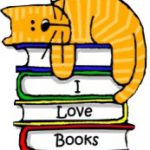
It’s Lucinda again, ready to give you another cat book summary and review. This time, I will be discussing Winnie the Pooh, by A. A. Milne. I have to admit that I had to read this book twice. It was easy enough to read, but the first time through I just couldn’t understand it.
Each chapter was a story, complete in itself. Each of these stories covered a new adventure that the characters had. I understood a bit better after my first reading, when I looked up the author and discovered he had written these stories for his small son.
I also read a little in the Tao of Pooh, by Benjamin Hoff. In it, Mr. Hoff explains that the book can teach you to be calm and happy in any circumstances, no matter what.
There is a narrator who tells the story. The two-legged character in the book is a small boy named Christopher Robin. I am guessing that he is the author’s son. The other characters are all toy animals belonging to Christopher Robin.
The second time I read the book, it made a lot more sense. These are make-believe stories. They are play adventures that Christopher Robin and his toys have together, in the world of Christopher’s imagination. I did a bit of research to learn the meaning of that word. Imagination allows you to create any idea in your head and then if you wish you can pretend that it is real.
That’s why all the animals can talk. Imagination allows anything to happen that you want to happen. Very nice — too bad we can’t 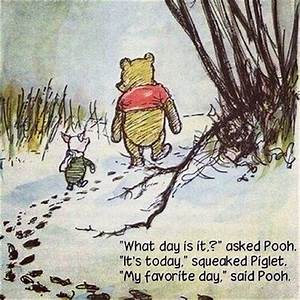 share our imagination with our own kind easier.
share our imagination with our own kind easier.
I did realize, though, that when I was just a kitten, my brothers and sisters and I had many imaginary adventures. We learned things from our mothers that we then had to apply to our lives. To do so, we created pretend stories where we could practice our new skills with each other through play.
Now let’s look at the stories. In the first one, Pooh, who is a small bear, wants to get to a beehive in the top of a tree. He wants to steal the bees’ honey.
He tries to climb the tree, but falls down. I remember when we were kittens, my siblings and I tried to learn to climb trees. We’d get a short distance up, but were too little to climb to the top. Our claws were not long and strong enough yet. So we’d fall back down. However, these attempts taught us how to climb and made us stronger.
Then Pooh gets the idea to borrow a balloon from Christopher Robin. Pooh will fly to the top of the tree. He rolls in mud first to try to make himself look like a dark cloud. However, the bees see through his disguise and are ready to attack. Christopher Robin, to save Pooh, shoots the balloon with his toy gun, and Pooh falls to the ground, still holding the balloon’s string.
I should have figured out that these stories were not real happenings when I read about Christopher Robin shooting the balloon with his toy gun. I thought perhaps this was another bit of two-legged magic. Now I understand that it was what is called play-acting.
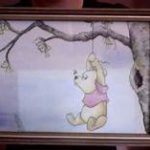 There is a lesson here about having faith in a good outcome. Pooh lands, still holding that string. It’s almost as if he does not fall, but lands safely. There is no mention of his receiving any injury from the fall. Also, Pooh remains calm and in control throughout the adventure, demonstrating a good attitude toward adversity and failed goals.
There is a lesson here about having faith in a good outcome. Pooh lands, still holding that string. It’s almost as if he does not fall, but lands safely. There is no mention of his receiving any injury from the fall. Also, Pooh remains calm and in control throughout the adventure, demonstrating a good attitude toward adversity and failed goals.
In the second chapter, Pooh goes to visit Rabbit. When he gets there, Rabbit will not let him in. He tries to convince Pooh he is not home, as he plans to go to Pooh’s for a visit. Of course Rabbit is home. Pooh is talking to him.
Have you ever played with your siblings and changed the rules as you played? When you are playing imaginary games, you can do that if you wish. We seem to have an example of that behavior here. Pooh finally convinces Rabbit that it is really him, and Rabbit lets him in.
But why would a bear and a rabbit be friends? In real life, the bear would have eaten the rabbit. As far as that goes, if I had been there, I might have made a meal or two of him, too. When I realized that these toys were toys and not real animals, I could see that the author had given each of these toy creatures certain characteristics, as a way to make a point.
After all, we are all different. In my large family, each of us had a slightly different personality and skill. For example, I had one brother 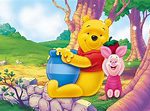 who became an excellent hunter. He would have made short work of a rabbit. I had one sister who was what the two-leggeds call a “scaredy-cat.” She was afraid of everything and spent a lot of time hiding.
who became an excellent hunter. He would have made short work of a rabbit. I had one sister who was what the two-leggeds call a “scaredy-cat.” She was afraid of everything and spent a lot of time hiding.
In this story, Rabbit was the kind of animal that wanted to be in control of everything and everyone in his life. He could get rather demanding of his friends.
Back to the story — Rabbit finally lets Pooh in, and Pooh asks for something to eat. Rabbit gives him bread and a whole pot of honey. Of course, Pooh eats it all. When he is ready to leave, he has gotten so fat that he can’t get out of Rabbit’s door. Christopher Robin comes by and says he will just have to stay there for a whole week until he is thin enough to get out. Then the friends come and pull him out the door.
If I ate that much, I, too, could have trouble fitting through a small door. I have a built-in measuring device for small spaces. If my whiskers fit through, the rest of me will also fit. If the whiskers won’t make it, neither would the rest of me.
In Chapter Three, Pooh visits Piglet, where he walks in circles in the front yard as Piglet shovels snow from his door. Then Piglet sees footprints and becomes afraid. He thinks they were made by a creature called a “woozie.” The two try to follow the footprints and in the process add their own. They never realize that they are following their own footsteps the whole time.
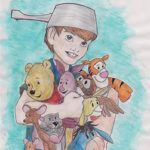 Finally, Piglet leaves because he is scared (he’s just like my timid sister) and Christopher Robin explains to Pooh that they were following their own tracks. They both have a good laugh.
Finally, Piglet leaves because he is scared (he’s just like my timid sister) and Christopher Robin explains to Pooh that they were following their own tracks. They both have a good laugh.
In Chapter Four, Eeyore the donkey is very depressed. His tail is missing. He tends to be the worrier among the animals, and seems to become stressed easily. However, losing one’s tail is no trifling matter. Why, if I lost my tail, I’d lose part of each sentence in my conversations with others, as my tail sometimes says it all.
Here is more proof that these animals are toys, and their adventures are made-up stories. After all, I would know immediately if I lost my tail. Also, I think it would hurt, and Eeyore never complains of pain. He just can’t find his tail.
They all go to see Owl, a creature they think of as wise. I think he comes off at times as being rather pompous. He also doesn’t tell the truth. He suggests posting a reward notice for the person returning the tail. Then Pooh sees the tail on Owl’s bell-pull, and returns it to Eeyore.
Not only did Owl lie, but he is the one who stole the tail in the first place. He probably suggested the reward so he could return the tail and collect. However, Owl is not punished for his thievery. Once the tail is returned, the issue is dropped.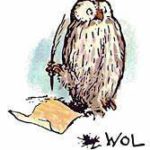
These toys are better at forgiving each other than many of the two-leggeds I have seen. They somehow move through problems and turn them into non-issues. Well done!
It was the same in my family. We played together, and sometimes we argued. However, such disagreements were soon forgotten and we all returned to caring for each other as family and friends.
In the next chapter, Pooh and Piglet decide to capture a heffalump. Now, there is a creature I have never seen, so I don’t know what they are talking about. Perhaps they invented this creature?
Anyway, the two dig a large pit. In the bottom they put a full jar of honey to attract the heffalump. But instead, it is Pooh who gets caught. He gets hungry and climbs in the pit for the honey. The honey jar gets stuck on his nose — that’s what he gets for being so greedy — and he doesn’t know how to remove it. He cries for help.
Piglet finds him, becomes frightened, and goes to Christopher Robin. Christopher laughs when he sees Pooh.
Now on to Chapter Six. In this chapter, Eeyore is again being his moody self. This time he is upset because it was his birthday but no one brought him any presents. What a whiner!
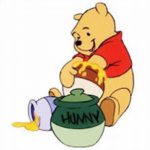 Now, in cat society, it is not usual to give birthday gifts. The only gifts I ever received were some toys and occasionally a treat from the CCL. She gave me these things because it was her custom to give presents.
Now, in cat society, it is not usual to give birthday gifts. The only gifts I ever received were some toys and occasionally a treat from the CCL. She gave me these things because it was her custom to give presents.
I will confess to bringing the CCL a gift from time to time, but I think of it more as returning a favor. The CCL provides me food, so occasionally I bring her fresh meat to help her with her own food. It is the least I can do.
In the story, because Eeyore is unhappy, Pooh feels unhappy, too, and decides to give Eeyore a jar of honey as a birthday present. He has Owl write “Happy Birthday” on it.
On the way to Eeyore’s, he meets Piglet, who decides he will give a present too — one of his balloons. Pooh forgets that the honey is a present and eats it all. Piglet falls on the balloon and breaks it. They give the empty jar and the broken balloon to Eeyore anyway.
Eeyore is a bit disappointed in his gifts until he discovers that the balloon will now fit in the jar. There’s a good example of making the best of what you have.
Then Christopher Robin tells the animals that there will be a birthday party for Eeyore, at which he receives a box of paints. All ends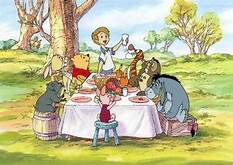 well for the friends.
well for the friends.
It is very good that these animals remain friends through all their adventures, and never resort to destructive anger to get their way. This lesson is a good one for two-leggeds, and for animals, too. We cats, however, do not hold onto negative emotions for long. We forgive easily, and when we bond with anyone, our love is unconditional.
In Chapter Seven, new arrivals come to the 100-Acre Wood. They are Kanga and her baby, Roo. This Kanga animal is a strange one, unlike any I have ever seen. My mother would have benefited from a pouch like Kanga’s. She was always gathering us up or searching for us or carrying us to a new bed. Unless we were eating, she had trouble keeping track of us. A pouch like Kanga’s would have saved her lots of trouble.
This chapter highlights a problem that is too common. Many of us — animals and two-leggeds alike — tend to be critical of someone new or someone not like us. This behavior is based on untrue beliefs, called prejudice, and is very negative.
Rabbit, of course, is the ringleader. Here is a newcomer who is different from he, and not under his control. He comes up with a plan. He will kidnap Roo, and when Kanga discovers Roo is missing, Rabbit believes she will leave.
Piglet is to hop into Kanga’s pouch, and Rabbit will steal Roo. All goes well until Kanga, very nearsighted, does not recognize Piglet and gives him a bath.
This won’t do. Piglet is scared of baths. He escapes and runs away. (Is there anything he is not afraid of?)
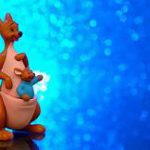 Funny, how things turn out. Rabbit, who first came up with the plan, becomes great friends with Roo, and Pooh and Kanga also become friends. Now the two are accepted, and peace again comes to the Wood.
Funny, how things turn out. Rabbit, who first came up with the plan, becomes great friends with Roo, and Pooh and Kanga also become friends. Now the two are accepted, and peace again comes to the Wood.
The next chapter is about a really grand adventure, when Christopher Robin leads the animals on an expedition to find the North Pole.
They have no concept of the real North Pole, and plan to go look for a pole stuck in the ground somewhere to the North. I certainly understand their confusion as I, too, had no idea what they were talking about until I looked up “North Pole.” I am so lucky, to be able to read.
Expedition members look far and wide for the pole, with no success. Then Roo falls into a pool of water, and Pooh reaches in with a pole to rescue Roo. The animals see the pole and decide it is the North Pole, so the expedition has been successful.
Oh, yes, we have played games like these. We have chased a small creature and pretended it was some huge wild beast we had to conquer. Once when we were quite little, I fell in a hole, and my siblings had to get our mother to come to the rescue.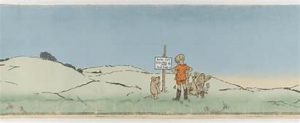
We also sometimes believed that something we didn’t understand could be a real threat to us, when it was innocent of any mischief. Isn’t that what happens at times when we are confronted with something new? We don’t understand it, so we fear it.
For example, the CCL had a couple of stuffed animals (I’m not sure what use she had for those, but there they were.) When we were kittens, we believed these creatures were real, and we would stay away from them.
Occasionally, however, one or the other of us would sneak up on the creature, and bat it severely with our paw. When it didn’t attack us, we would bravely attack it, hoping to put it out of commission before it awoke and came after us. It was a long time before I realized that I would not be harmed by that creature.
In the next chapter about Pooh, the 100-Acre Wood has received enough rain to form little ponds on the forest floor. A large pond forms near Piglet’s house, and soon he is surrounded by water. He is afraid of drowning, so sends a note in a bottle to his friends.
Pooh finds the note and takes it to Christopher Robin. Christopher asks Owl to fly to Piglet and tell him rescue is on the way.
The friends try to think of a way to rescue Piglet. Pooh comes up with the best idea. Using Christopher Robin’s umbrella as a boat, Pooh floats to Piglet and rescued him. Clever Pooh! One good idea was all it took.
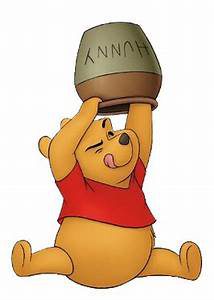 In the final chapter, Christopher Robin gives a party for Pooh, for his successful rescue of Piglet. As animals and people love to party, it must have been a great success.
In the final chapter, Christopher Robin gives a party for Pooh, for his successful rescue of Piglet. As animals and people love to party, it must have been a great success.
I do hope the treats were partly meat and not just sweet things like cake. I just can’t understand why sweet things taste so good to these creatures. Personally, I don’t care for them — give me a piece of fresh fish, chopped fine, if you please.
At the party, Christopher Robin had a gift for Pooh. The gift is passed to him, but it is first handed to Eeyore. He thinks the gift is for him and makes a speech. Christopher Robin corrects the mistake, and Pooh unwraps his gift.
It contains a special pencil case marked HB for Helping Bear. The pencils are marked BB, for Brave Bear. The party ends on a happy note.
Pooh deserved an award. Through all their adventures, he kept his head and encouraged his friends. He was calm, never got angry, and was always willing to help out if he could.
This is a good lesson for all of us. Perhaps we should be a little more like Pooh.
If you would like to get a copy of Winnie the Pooh, here is a hard copy of the book from Amazon. Please note that as an Amazon affiliate, I may make a small commission from your purchase.
. Click on the image or on the blue title and you will be taken to the site where you can purchase the book.
Hardcover copy, full color
Price: $22.99
Prime



Winnie the Pooh is my all time favourite Lucinda
I have spent hours reading AA Milne to my children when they were small and now they do the same with their children
This review is wonderful
You are so clever and keep on taking CCL treats as we don’t want her to fade away 🙂
Oh, yes, treats…I am not sure how she prepares the meat I bring her, but she does thank me. I guess she likes it. I know she liked it when Carlos brought her a rabbit because then she could make rabbit stew. However, I am not as big a cat as Carlos, and not as adept at hunting. I will do what I can, though. I am so glad you like my stories. Having “fans” makes it much more satisfying to write them. Lucinda